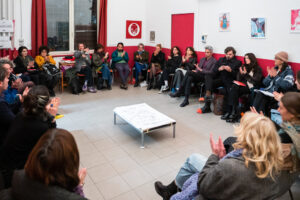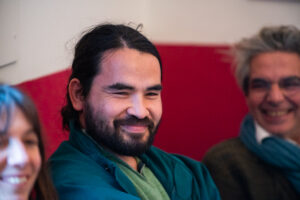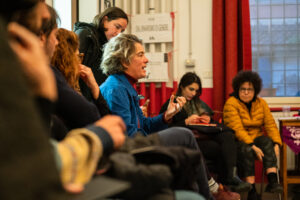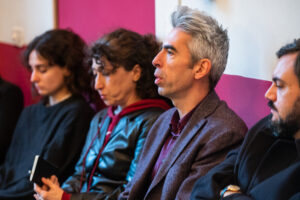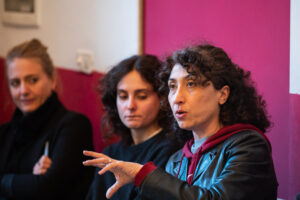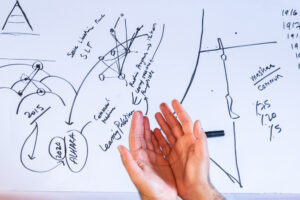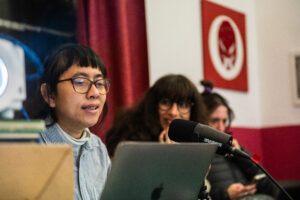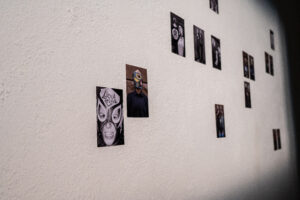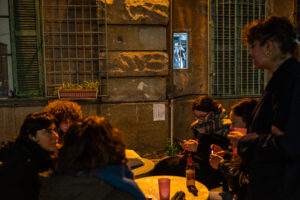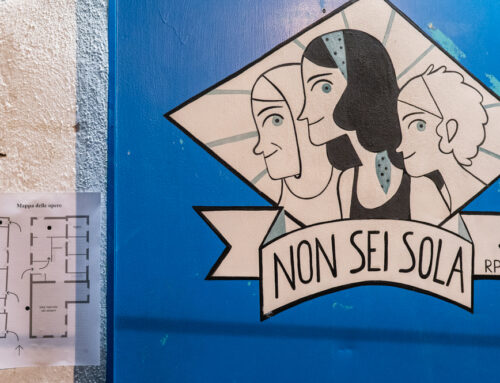A Practical Exploration of
Prefigurative Politics
Text by Aria Spinelli
The Prefiguring World(s) Through Artistic Practice event, a unique culmination of two years of research on artistic practices, self-organisation, and institutionalism in Rome, took place in December 2023. This event, the result of a Postdoctoral Fellowship with ASCA for the IMAGINART project, provided a ‘practical manifestation’ of the concept of prefigurative politics. The event I had the privilege to interpret and organise was an intensive exploration of how individuals and groups can embody their visions of a future society in their present actions and conceptually prefigured new social relations (Cooper 2014). It featured two artist presentations, an exhibition and a panel with eleven practitioners in the Lucha y Siesta building in Rome, offering a unique perspective on the context of artistic and cultural production in the city and the broader national context that led to the construction of the event.
The need for more institutional infrastructure in the cultural and artistic sectors for socially and politically engaged practices and the lack of relationality among various national agencies, practitioners, and local policymakers often hinder the potential for a significant impact on the status quo, as mentioned by Marina De Angelis. I brought together an extensive network of like-minded, engaged practitioners to address this. The aim was to foster a space for unforeseen developments to emerge. While more extensive museum settings offered programming to challenge contemporary cultural production, as in the case of Museo della Civiltà in Rome, local practitioners, such as Stalker, Locales or Serena Olcuire, collaborate with large networks of activists, forging relations between museums, universities, and independent art spaces. More embedded practices, such as those of MAd’O, Museo dell’Atto di Ospitalità (Museum of the Act of Hospitality) or MAAM – Museo dell’Altro e dell’Altrove (Museum of the Other and Elsewhere), show how integrated cultural practices can be, traversing complex relations between social movements, politicians, and the arts sector. These examples were brought to the table through the many voices of the people behind them, crossing several cities in Italy, including Florence, Venice, and Naples, such as artist Maria Pecchioli.
.
I was also keen on creating a trans-local exchange of cultural practices, inviting fellow IMAGINART colleagues Yazan Khalili and Nuraini Juliastuti to participate and contribute to the discussion around experimental institutionalism in Rome. In our podcast, Juliastuti, Khalili, and I discuss how notions of care are commonly addressed in practices in Palestine and Indonesia.
The event provided tangible evidence of several key factors that permeated my research and were reaffirmed during this final event.
The first and foremost was the notion of autonomy understood and actively embraced, through the multifaceted approaches to activist and artistic work. The Italian tradition of critical thinking around autonomy (Hardt & Negri 2005) was evident in some practices presented on the panel, such as IRI, Institute of Radical Imagination, Sale Docks, or Ex-Asilo Filangeri. However, there was also a profound understanding of autonomy as practice, heavily influenced by the Zapatista movement or anarchist principles of autonomy, as we have gleaned from David Graeber’s revolutionary thinking (Graeber, 2011)—these innovative understandings of practice position production outside the political governance frameworks of the city. Here, relationships are nurtured based on equality and awareness, often forcing city officials to reckon with what has been created autonomously. The second aspect was the notion of instituency (Raunig et al., 2013), which permeated most of the work discussed during the panel. Through a dual action of infrastructural building and collective critical reflection, institutional experimentation in the arts in Italy often enhances alternative contexts for welfare, cohabitation, and gender equality, creating self-made policies. This happens in a unique setting where practices that rely on self-organisation are often integrated within an extensive framework of institutional relationships ranging from local city council officers to national government officials. Within this plethora of transversal power structures, spaces like Lucha y Siesta remain afloat because they are embedded in regional networks, creating ample community support for the struggle. The practices of care and solidarity are happening throughout the infrastructure of Lucha y Siesta and amongst the group of practitioners contributing to the programme. Anahi Mariotti and Sofia Moriggi, through the works on show at their exhibition, captured the nature of the relations between the group at Lucha y Siesta and the broader community of fellow activists, a relation that was made of gestures of affection, companionship, and strength.
The resilience of Italian contemporary independent, socially and politically engaged artistic and cultural production is truly remarkable. Despite navigating a challenging institutional setting, lack of funding structures, and political interference with cultural management, diverse cultural practitioners persist in their efforts to practice culture and art in ways that anticipate better futures. Their unwavering commitment to addressing inequality, gender violence, and precarity through their work is a testament to their dedication and the importance of their contributions, inspiring admiration in all who witness their efforts.
Bibliography
